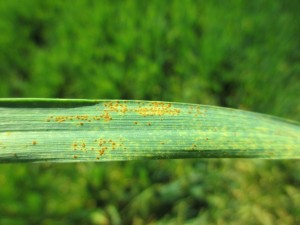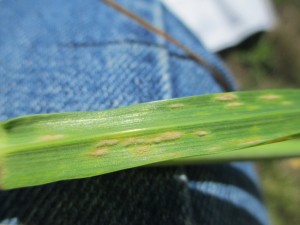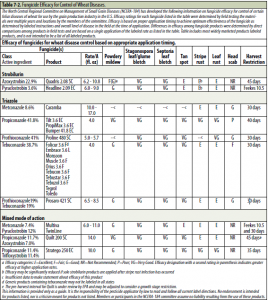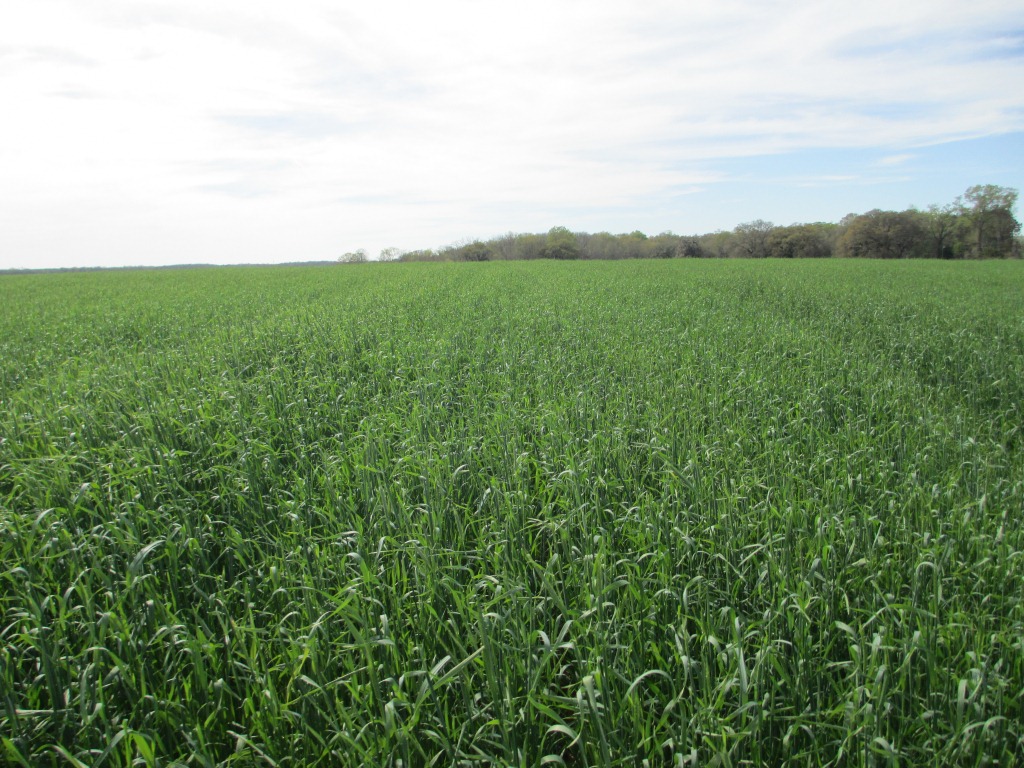- Many small grains in the Panhandle are in boot stage or just beginning to flower. Photo Credit: Josh Thompson
Considerable acreage of wheat and other small grains was planted this past fall because of the favorable prices. Much of the fall planted crop is already in boot and flowering stages. One question that every grower will need to answer is, “Do I need to use a fungicide?” Although the window for application is closing, there is still time for some fields.
Every year there is a presence of yield-reducing fungal pathogens that cause Leaf Rust (Puccinia recondite) and Powdery Mildew (Erysiphe graminis), as well as other diseases, in wheat, oat, and rye. The severity of disease is dependent upon the presence of the host plant (wheat, oats, rye) the presence of the pathogen, and a favorable environment. This year, all three have been present which has already led to some severe cases of disease.
Both Leaf Rust and Powdery Mildew have been found in several locations in wheat and oats in Jackson and Washington Counties (See pictures below). Both diseases have the potential to decrease yields significantly.

Leaf Rust can be identified in small grains by the small, rust colored pustules on the undersides of leaf blades.

Powdery Mildew can be identified in small grains by its small, gray pustules on the underside of leaf blades
The best defense against most diseases is to plant resistant varieties. Also, growers should be sure to have proper plant populations and nitrogen fertilization, as rank growth can lead to increased severity of fungal disease. In addition to these practices, fungicides may or may not be required.
Do I need to use a fungicide? To answer this question, answer the following questions:
1.) Do I have the pathogen present in my field and is it affecting the top portion of the canopy?
This question is the first and most important to answer. The mere presence of the pathogen does not necessarily warrant the use of a fungicide. Lower, mature leaves are expected to yellow as the crop matures and even have some disease. It is only when the disease threatens the top 1/3 of the canopy that a spray may need to be triggered.
2.) Is my crop at flowering or Feekes scale 10.5 or earlier? (Feekes Scale)
Almost all fungicides labeled for small grains have a restriction on how late they can be applied. Also, many have grazing restrictions after time of application. Be sure to follow all label instructions when using a fungicide. Fungicides applied after the grains begin to fill will not benefit yield.
3.) Do I have the potential for a high yield?
A fungicide spray may range from $7 to $20 per acre depending on the product and application costs. This should be a consideration when deciding whether to apply. If yields are not expected to be high, or if disease is already too severe, it may not be economical to apply.
If you can answer yes to all three questions, than an application of a fungicide should be considered. Several different types of chemistries work well for Leaf Rust and Powdery Mildew. See the Figure below for the efficacy ratings of various chemicals for wheat. If applying to rye or oats, be sure to read the label to see if the product is labeled for use in that crop. If you have additional questions about small grain diseases, or need assistance identifying a disease, contact your local county extension agent.

Above is a table from the University of Kentucky that evaluates the efficacy of various wheat fungicides. Click on the table to view larger image.
- Carinata Starting to Come Up in Jackson County - December 12, 2014
- Wheat Production Considerations for 2014-2015 - November 10, 2014
- Peanut and Cotton Harvest Video 2014 - November 10, 2014

